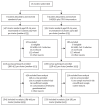Effect of a community-based intervention for sexually transmitted infections on population-level prevalence among youth in Zimbabwe (STICH): a cluster-randomised trial
- PMID: 39551057
- PMCID: PMC7617908
- DOI: 10.1016/S2214-109X(24)00373-5
Effect of a community-based intervention for sexually transmitted infections on population-level prevalence among youth in Zimbabwe (STICH): a cluster-randomised trial
Abstract
Background: Young people are at particularly high risk of acquiring sexually transmitted infections (STIs). We conducted a trial to investigate the effect of a community-based intervention that included STI screening among youth on population-level prevalence of STIs in Zimbabwe.
Methods: STICH was a parallel-arm, cluster-randomised controlled trial nested within CHIEDZA, a trial of community-based integrated HIV and sexual and reproductive health services for youth in Zimbabwe. STICH was conducted in Harare and Bulawayo provinces with eight clusters in each province, randomised 1:1 to control (existing health services) or to the intervention: community-based screening and treatment for Chlamydia trachomatis and Neisseria gonorrhoeae (males and females) and Trichomonas vaginalis (females only) offered over 12 months to intervention cluster residents aged 16-24 years who were attending CHIEDZA. Outcomes were ascertained through a population-level survey immediately after the intervention period, which included young people aged 18-24 years who lived in randomly selected households in each of the 16 clusters. The primary outcome was population prevalence of any (one or more) of the three STIs; secondary outcomes were prevalence of each of the three STIs. The STICH trial is registered with ISRCTN registry, ISRCTN15013425, and the CHIEDZA trial is registered with ClinicalTrials.gov, NCT03719521.
Findings: From Oct 6, 2021, to March 8, 2022, 6361 randomly sampled young people were recruited into the outcome survey (median age 20 years [IQR 19-22], 3500 female and 2101 male, 3066 in intervention clusters and 3295 in control clusters). 5601 participants were included in the primary outcome analysis (2756 in intervention clusters and 2845 in control clusters). In the intervention clusters, 612 (22·2%) of 2756 participants reported that they had attended CHIEDZA and 298 (10·8%) had been tested for C trachomatis and N gonorrhoeae. In the control clusters, 113 (4·0%) of 2845 participants had attended CHIEDZA and 40 (1·4%) had been tested for C trachomatis and N gonorrhoeae. In the outcome survey, the cluster-level geometric mean prevalence of the primary outcome (any of C trachomatis, N gonorrhoeae, and T vaginalis) was 19·07% (geometric standard deviation [GSD] 1·20) in the intervention arm versus 19·95% (GSD 1·10) in the control arm (risk ratio [RR] 0·93 [95% CI 0·78-1·10]; p=0·35). There was no difference between arms in geometric mean prevalence of C trachomatis (12·86% [GSD 1·14] in the intervention arm vs 12·94% [GSD 1·15] in the control arm, RR 0·97 [95% CI 0·84-1·11]; p=0·60) or T vaginalis (7·06% [GSD 1·48] vs 6·20% [1·38], RR 1·09 [95% CI 0·74-1·60]; p=0·66). N gonorrhoeae prevalence was significantly lower in the intervention arm, with a 43% risk reduction (geometric mean 1·65% [GSD 1·77] vs 2·87% [1·43], RR 0·57 [95% CI 0·34-0·96]; p=0·036).
Interpretation: Our study showed high population prevalence of curable STIs. Community-based STI screening appeared to reduce population-level prevalence of N gonorrhoeae, but not of C trachomatis or T vaginalis, probably due to low intervention coverage. Future research is needed on the effects of screening interventions on morbidity, antimicrobial resistance, and re-infection rates.
Funding: Medical Research Council, Economic and Social Research Council, Department for International Development, National Institute for Health and Care Research, and the Wellcome Trust.
Copyright © 2025 The Author(s). Published by Elsevier Ltd. This is an Open Access article under the CC BY 4.0 license. Published by Elsevier Ltd.. All rights reserved.
Conflict of interest statement
Declaration of interests KM has received funding from FIND to validate a novel lateral flow assay for gonorrhoea and a loan of a GeneXpert Machine. KM is also the recipient of a Wellcome Trust grant for a clinical PhD fellowship assessing point-of-care testing for STIs (Grant number 225468/Z/22/Z). All other authors declare no competing interests.
Figures
References
-
- WHO. Global Health Sector Strategies on, respectively, HIV, viral hepatitis and sexually transmitted infections for the period 2022–2030. World Health Organization; Geneva: 2022.
-
- Chesson HW, Mayaud P, Aral SO. Disease control priorities, 3rd edn (vol 6): major infectious diseases. The International Bank for Reconstruction and Development–The World Bank; Washington, DC: 2017. Sexually transmitted infections: impact and cost-effectiveness of prevention; pp. 203–32. - PubMed
Publication types
MeSH terms
Associated data
Grants and funding
LinkOut - more resources
Full Text Sources
Medical



